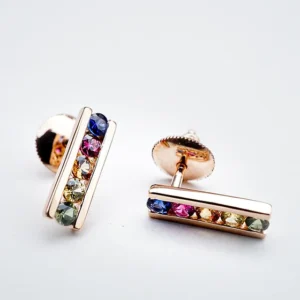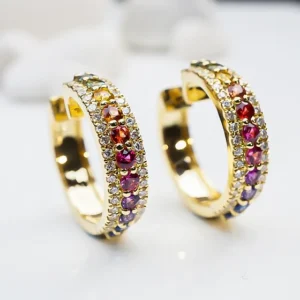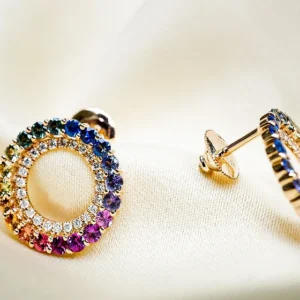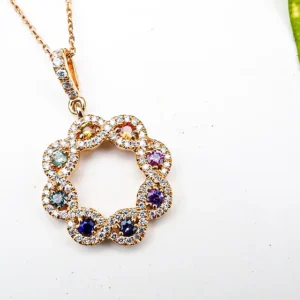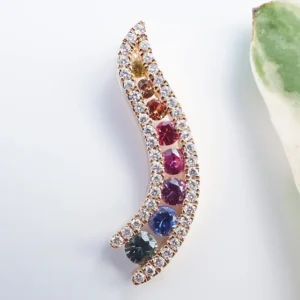Emerald: The Enchanting Green Gemstone for Exquisite Jewelry
Emeralds, renowned for their captivating green hues, are cherished gemstones that have held a special place in history, culture, and modern jewelry design. As the birthstone for May, emerald gemstones have captured the hearts of many with their vibrant color and alluring beauty.
Table of Contents
In this comprehensive article, we will explore the world of emeralds, from their historical significance to their role in creating stunning pieces like emerald rings, emerald necklaces, and emerald earrings. Let’s embark on a journey through the fascinating realm of emerald jewelry.
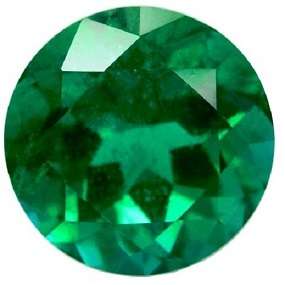
An Emerald
Introduction
Emeralds, boasting their vibrant and luxuriant green hues, have held humanity spellbound for countless centuries. These precious emerald gems are revered not merely for their captivating beauty but also for their profound cultural resonance and historical significance.
From the ancient civilizations that revered them as symbols of renewal and vitality to the modern-day aficionados of exquisite jewelry, emeralds have consistently occupied a cherished and revered corner in the tapestry of human admiration.
Their luminous green color evokes the lushness of nature and the rejuvenating energies it embodies, forging an unbreakable connection between these gems and our innate desire for vitality and harmony.
History and Lore of Emeralds
The history of emeralds is deeply intertwined with captivating legends and ancient beliefs. In diverse cultures, emerald stones were regarded as vessels of mystical powers, believed to bring protection and healing to those who possessed them.
The mesmerizing green gem was considered a conduit to connect with nature’s energies, fostering a sense of balance and well-being. Cleopatra, the legendary Egyptian queen renowned for her beauty and elegance, held a profound fascination for emeralds.
She adorned herself with exquisite emerald jewelry, not only to enhance her allure but also to harness the gem’s mystical properties. Across the epochs, emerald rings, emerald necklaces, and emerald earrings have continued to embody notions of opulence and refinement, elevating these gemstones to symbols of enduring luxury that transcend time.
Formation and Characteristics of Emerald Gems
Emerald gemstones, a type of beryl, derive their captivating green color from trace elements like chromium and vanadium. The distinctive geological conditions required for their formation result in the mesmerizing green hues that make an emerald so desirable.
These gems’ internal inclusions, known as the “jardin,” contribute to their character and authenticity, resembling intricate patterns that tell the story of their natural origin.
Symbolism and Cultural Significance
Emeralds are far more than exquisite gemstones; they encapsulate profound symbolism that resonates deeply with the human experience. The verdant hue of an emerald carries associations of growth, renewal, and vitality, mirroring the rejuvenating essence of nature itself.
It’s no wonder that emeralds have become a cherished choice for commemorating love and life’s milestones. Whether adorning emerald engagement rings or the timeless elegance of emerald cut engagement rings, these gemstones hold the power to express a myriad of emotions and aspirations.
Beyond their visual allure, an emerald embodies sentiments of hope, renewal, and enduring love. The act of presenting an emerald engagement ring goes beyond the aesthetic; it becomes a profound declaration of commitment and the promise of a future adorned with the same vitality and growth symbolized by these enchanting gemstones.
Factors Influencing Value: The 4 Cs of Emerald Gemstones
Carat Weight
Carat weight holds a significant role in the allure of emeralds, contributing to their unique beauty and value. Unlike some gemstones where size alone dictates their worth, a value of an emerald is intricately linked to their color, clarity, and overall quality. When considering the carat weight of an emerald, it’s essential to strike a harmonious balance between size and the gem’s other attributes.
A larger emerald might be captivating, but it’s the combination of a rich, vibrant green color, exceptional clarity, and minimal inclusions that truly define the gem’s worth. An emerald’s carat weight becomes a complementary factor in enhancing its overall charm, with the gem’s brilliance and color taking precedence.
As you explore emerald jewelry, whether it’s an emerald necklace, emerald ring, or any other piece, remember that while carat weight plays a role, it’s the gem’s intrinsic qualities that truly make it shine.
Color
Color is an intrinsic and mesmerizing facet of emeralds, wielding an undeniable influence on their allure and value. The lush green hue that defines emeralds is a symphony of nature’s mastery, ranging from serene and calming shades reminiscent of new leaves to deep, intense greens evoking the heart of untouched forests.
The value of an emerald is intricately tied to the depth and saturation of its green color, with the most sought-after gems exhibiting a vivid, even distribution of color throughout the stone.
It’s this captivating color that resonates with emotions of growth, vitality, and renewal, creating an innate connection between the gem and the world it draws inspiration from. As you admire emerald jewelry, whether it’s an emerald bracelet or emerald earrings, the enchanting interplay of color within these gems serves as a reminder of the beauty and harmony found in the natural world.
Clarity
Clarity, an essential characteristic in the world of gemstones, holds a unique charm when it comes to an emerald. The mesmerizing green allure of an emerald often conceals a world of intriguing inclusions, affectionately referred to as the “jardin.”
Unlike other gemstones where flawless clarity is paramount, these internal formations in emeralds are considered part of the gem’s character, a testament to its natural origin and journey within the Earth’s depths.
While some inclusions might affect transparency, it’s the way they interact with light that adds depth and uniqueness to each emerald. Finding an emerald with good clarity becomes an art of balance, where the presence of inclusions doesn’t overshadow the gem’s captivating color and overall appeal.
In the world of emeralds, clarity weaves a story of the gem’s formation, presenting an invitation to explore its intricacies and embrace the beauty of imperfections.
Cut
The cut of an emerald is a delicate dance between artistry and science, shaping not just the gem’s appearance, but also its brilliance and character. Unlike other gemstones, an emerald possesses unique challenges due to its natural inclusions, often referred to as the “jardin.” A skilled lapidary craftsman must carefully consider the gem’s size, color, and inclusions while fashioning the cut.
The goal is to create a cut that maximizes the gem’s brilliance by allowing light to interact with the inclusions in a harmonious way. The classic emerald cut, characterized by its rectangular shape and stepped facets, was born out of the need to work with these distinctive gem properties.
A well-executed cut not only accentuates the captivating green hue of an emerald but also accentuates the play of light and shadow within the gem. In the world of emeralds, the cut is a testament to the lapidary’s skill and the gem’s natural beauty, inviting us to appreciate the delicate balance between precision and the inherent allure of imperfections.
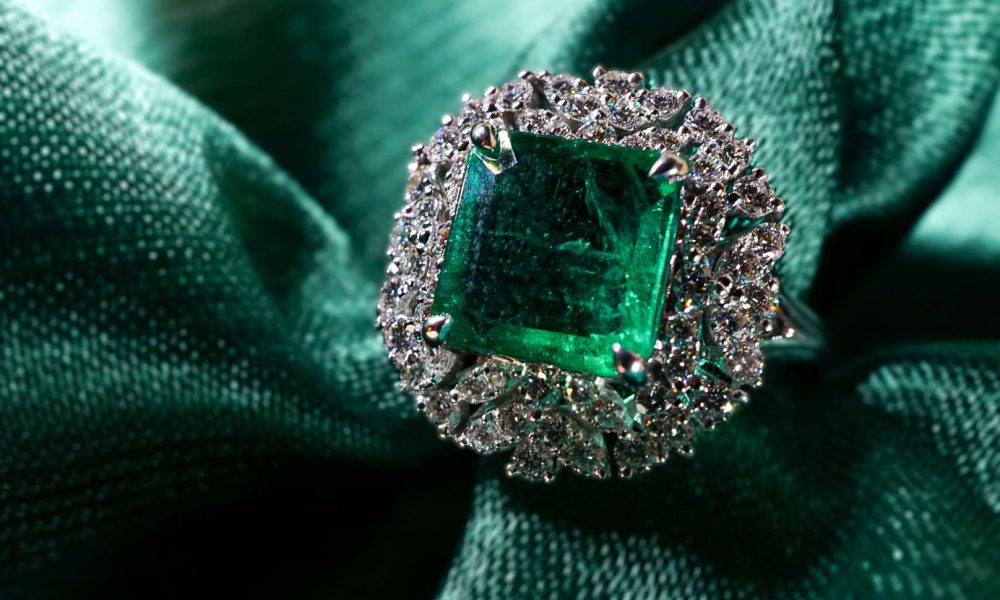
An Emerald Diamond Ring
Types and Varieties of Emeralds
From emerald rings for women that encapsulate elegance and sentiment, to emerald necklaces that grace the neckline with enchanting allure, and emerald stud earrings that add a touch of sophistication, the versatility of showcasing these gemstones knows no bounds.
Within the realm of emeralds lies a world of diversity, where Colombian emeralds stand out for their deep and captivating green hues, evoking the lush landscapes that birthed them. On the other hand, Zambian emeralds are revered for their vivid color saturation, radiating an intensity that draws the eye and captures the imagination.
Each variety, be it the timeless charm of Colombian emeralds or the vibrant allure of Zambian emeralds, weaves a unique narrative in the tapestry of gemstone appreciation. With every facet and cut, these emeralds tell a story, a testament to the intricate beauty of nature’s palette and the craftsmanship that reveals its brilliance.
Selecting the Perfect Emerald
Whether the occasion calls for the timeless elegance of an emerald cut engagement ring that embodies eternal love or the exquisite charm of a statement emerald bracelet that graces the wrist with sophistication, the journey of selecting the ideal emerald gem is one that demands thoughtful deliberation.
Every emerald gem is a work of nature’s art, a masterpiece of color, clarity, cut, and carat weight that meld together to create its distinctive allure. The vibrant green hue, the way light dances through the gem’s inclusions, the precision of its cut, and the balanced carat weight – each element contributes to the gem’s unique personality.
As you embark on this journey of choosing the perfect emerald, remember that it’s the culmination of these factors that creates a gem that speaks to your heart and reflects your unique style, ultimately encapsulating the emotions and moments you wish to cherish forever.
Creating Exquisite Emerald Jewelry
Emerald jewelry, a realm of artistry and expression, transforms these captivating gemstones into wearable masterpieces that resonate with brilliance and elegance. Within this realm, emerald necklaces cascade like cascades of nature’s splendor, framing the neckline with a tapestry of green hues that draw the eye and evoke emotions.
Emerald earrings dangle like drops of enchantment, catching the light and casting a mesmerizing glow that illuminates the face. Emerald bracelets encircle the wrist with sophistication, each link a testament to the meticulous craftsmanship that ensures the emerald stone takes center stage.
Designers, akin to alchemists, delicately balance metal and gem, sculpting settings that amplify the gem’s natural allure. With each emerald carefully chosen, cut, and placed, every piece of jewelry becomes a symphony of beauty, a showcase of nature’s artistry and human ingenuity that captures the essence of the emerald’s journey from the earth to the heart.
Caring for Your Precious Emerald Jewelry
Preserving the timeless allure of your emerald jewelry demands diligent care, ensuring that the beauty of these gems endures through the ages. A simple ritual of gentle cleaning using a soft cloth and mild soap becomes a gesture of safeguarding the gem’s brilliance.
Gently wipe away the traces of time, allowing the emerald’s luster to shine anew on your emerald ring, emerald necklace, or emerald earrings. Yet, caution is your ally – shield these precious gems from the harsh touch of chemicals that might tarnish their radiance, and shelter them from the extremes of temperature that could mar their vibrancy.
By embracing this delicate balance of care, you gift your emerald jewelry the opportunity to transcend fleeting moments and become heirlooms that bridge generations, forever evoking the enchantment of the first glance.
Famous Emeralds: Treasures of the Past
Throughout history, specific emeralds have risen to legendary status, with gems like the Chalk Emerald and the Mogul Mughal Emerald weaving captivating tales of royal lineage and adventurous journeys.
These gems transcend their physical form, embodying the narratives of kings, queens, and explorers who sought their alluring depths, reminding us that emeralds are not just jewels; they’re conduits to history’s most captivating moments.
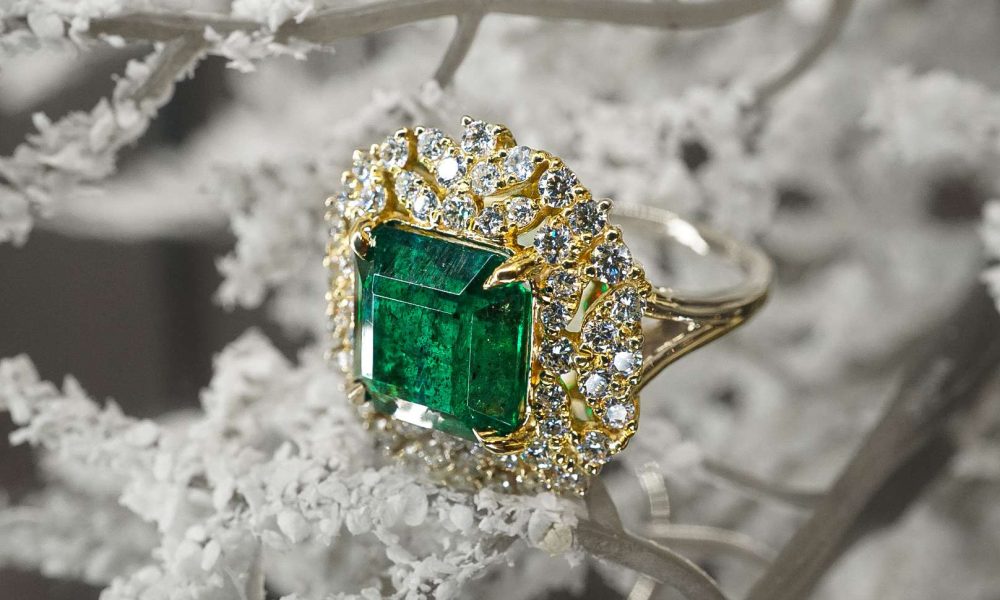
An Emerald Diamond Ring
Emeralds in Modern Jewelry Design
In the world of contemporary jewelry design, emeralds maintain their timeless appeal while embracing modern innovation. From elegant emerald pendants to captivating emerald diamond rings, designers seamlessly blend tradition and creativity, crafting pieces that capture the essence of these gemstones‘ enduring charm.
Sourcing Emeralds: Mining and Origins
Emeralds hail from various global sources, including Colombia, Zambia, Brazil, and Afghanistan, each bestowing distinct traits upon these gems. Colombian emeralds boast deep greens evoking their homeland’s lushness, while Zambian emeralds captivate with vibrant color.
Brazilian emeralds exude tropical warmth, and Afghan emeralds offer a rustic charm. This array of origins weaves a narrative beyond aesthetics, linking these gems to the diverse landscapes that nurtured their beauty.
Ethical Practices in Emerald Mining
As awareness of ethical practices grows, the emerald mining industry is striving to promote sustainability and fair working conditions. Responsible mining ensures that the beauty of emeralds doesn’t come at the cost of environmental degradation or human rights violations.
Investing in the Timeless Beauty of Emeralds
Whether your gaze is fixed on the elegance of an emerald bracelet, the sophistication of an emerald pendant, or the timeless allure of an emerald diamond ring, the decision to invest in emeralds carries the promise of a truly gratifying journey.
Beyond being cherished adornments, emeralds have the potential to evolve into valuable assets. High-quality emeralds, with their vibrant color, exceptional clarity, and skillful cuts, have the propensity to appreciate in value over time.
As the rarity of top-tier emeralds becomes increasingly evident, the allure of investing in these gemstones becomes even more compelling. Akin to a captivating story that unfolds with each passing year, emeralds have the ability to bestow not only the joy of ownership but also the potential for a rewarding financial return.
In a world where trends come and go, the timeless beauty of emeralds holds the promise of an enduring legacy that transcends fleeting moments.
Emerald Legends: Myths and Mystique
Emeralds have sparked captivating myths and legends across history, from ancient civilizations to modern tales. Associated with qualities like truth, protection, mysticism, and magic, these gems embody a spectrum of human emotions and aspirations, intertwining reality and fantasy in their alluring depths.
The Everlasting Allure of Emeralds
Amid the whirlwind of shifting trends, emeralds emerge as steadfast sentinels of enduring beauty and elegance. Their allure transcends fleeting fashions, casting a timeless spell that resonates across generations.
Be it the graceful promise of an emerald engagement ring, the captivating cascade of an emerald necklace, or the delicate allure of emerald stud earrings, these gemstones hold an indelible place within the realm of jewelry.
More than mere accessories, emeralds become cherished companions that evolve with us through life’s journeys, carrying with them the weight of emotions, stories, and aspirations.
As the world dances to the rhythm of change, emeralds stand as a testament to the eternal charm of nature’s creations, reminding us that within their verdant depths lies a steadfast elegance that defies the passage of time.
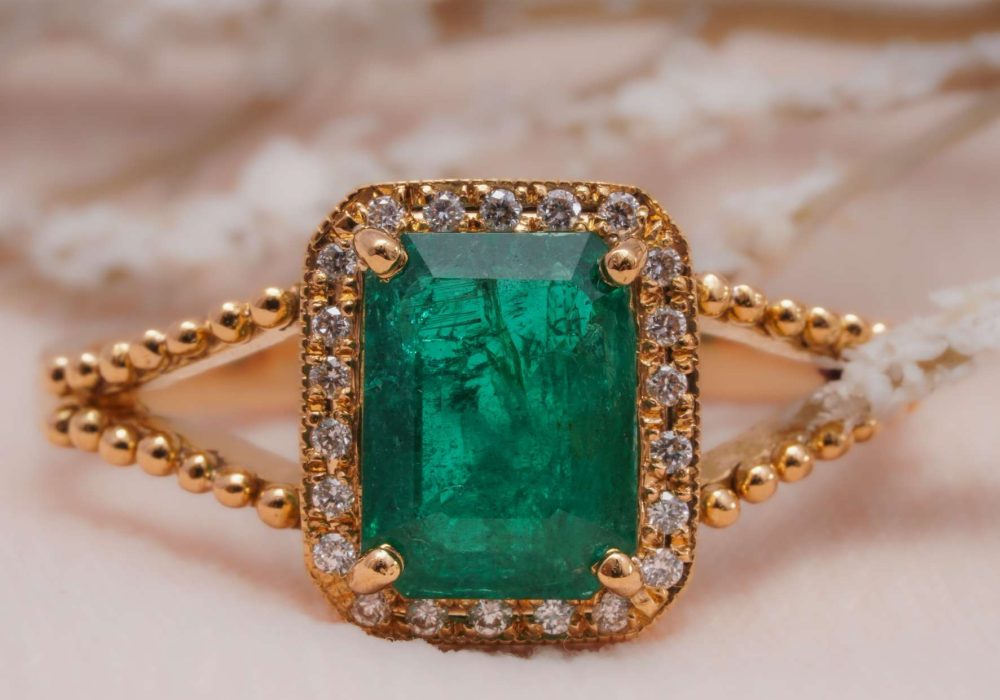
An Emerald Diamond Ring
Final Thoughts
Emeralds, with their captivating green allure, maintain an unyielding grip on the hearts of both jewelry enthusiasts and collectors, forging an unbreakable bond that transcends eras. Beyond their aesthetic splendor, emeralds hold a unique position as gatekeepers of history, their journey intertwined with ancient civilizations and royal legacies.
At the same time, they remain fervently relevant in the modern landscape of design, offering a bridge between tradition and innovation. This enduring fascination with emeralds underscores our deep-rooted connection to the world’s natural wonders.
With every glance into their depths, we are reminded of the Earth’s ability to transform raw materials into treasures that resonate with human emotion and aspiration. In a world that whirls with change, emeralds stand as a testament to the unwavering allure of the natural world’s beauty and the unbreakable thread that binds us to its splendor across time.
FAQs About Emeralds
An emerald is a gemstone belonging to the beryl family, characterized by its rich green color.
The green color of emeralds is attributed to trace amounts of chromium and vanadium in their crystal structure.
Emeralds are mined from various locations around the world, including Colombia, Zambia, Brazil, and Afghanistan.
Emeralds are distinguished by their lush green color and the presence of inclusions, often referred to as the "jardin," which are considered part of their character.
While emeralds are relatively hard, they can be susceptible to damage due to their inclusions. It's advisable to handle them with care and avoid exposure to harsh conditions.
Emerald is the birthstone for May and symbolizes rebirth and renewal, aligning with the vibrant green hues of spring.
To maintain the brilliance of your emerald jewelry, clean it gently using a soft cloth and mild soap. Avoid exposure to chemicals and extreme temperatures.
High-quality emeralds with desirable characteristics, such as vibrant color and minimal inclusions, have the potential to appreciate in value over time.
Emeralds from different sources, like Colombian and Zambian emeralds, have distinct characteristics, including color and color saturation, adding to their uniqueness.
The price of an emerald is influenced by factors such as color, clarity, carat weight, and origin. High-quality emeralds with intense green color and minimal inclusions tend to command higher prices.

